
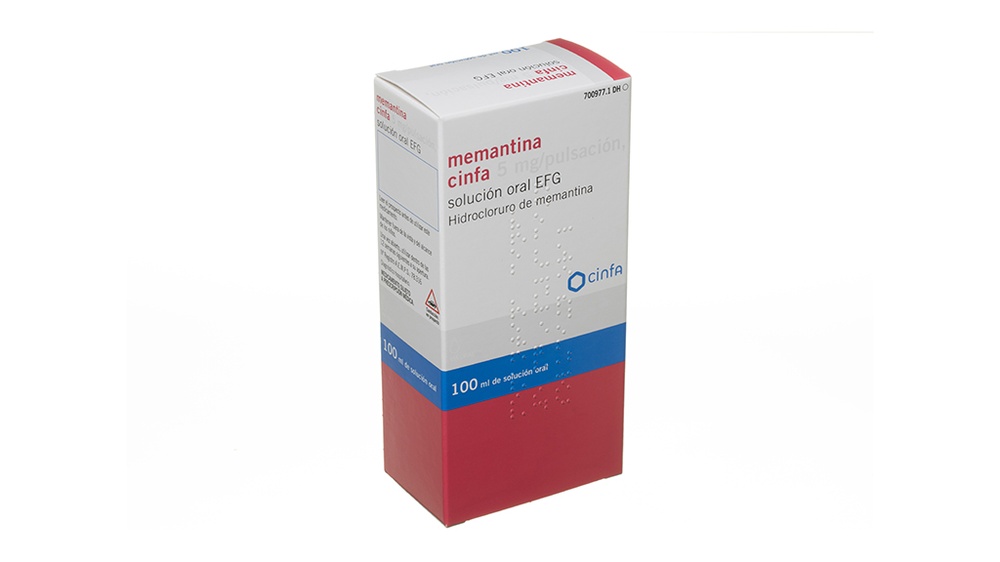
MEMANTINE CINFA 5 MG/DOSE ORAL SOLUTION

Ask a doctor about a prescription for MEMANTINE CINFA 5 MG/DOSE ORAL SOLUTION

How to use MEMANTINE CINFA 5 MG/DOSE ORAL SOLUTION
Introduction
Package Leaflet: Information for the User
memantina cinfa5 mg/pulse,oral solution EFG
Memantine hydrochloride
Read the entire package leaflet carefully before starting to take this medication, as it contains important information for you.
- Keep this package leaflet, as you may need to read it again.
- If you have any questions, consult your doctor, pharmacist, or nurse.
- This medication has been prescribed to you only, and you should not give it to others, even if they have the same symptoms as you, as it may harm them.
- If you experience side effects, consult your doctor, pharmacist, or nurse, even if they are side effects not listed in this package leaflet. See section 4.
Contents of the Package Leaflet
- What memantina cinfa is and what it is used for.
- What you need to know before taking memantina cinfa.
- How to take memantina cinfa.
- Possible side effects.
- Storage of memantina cinfa.
- Contents of the pack and further information.
1. What memantina cinfa is and what it is used for
How memantina cinfa works
Memantina cinfa contains memantine as the active substance.
It belongs to a group of medications known as anti-dementia medications.
Memory loss in Alzheimer's disease is due to an alteration in brain signals. The brain contains so-called N-methyl-D-aspartate (NMDA) receptors that participate in the transmission of important nerve signals in learning and memory. Memantina cinfa belongs to the group of medications called NMDA receptor antagonists. Memantina cinfa acts on these receptors, improving the transmission of nerve signals and memory.
What memantina cinfa is used for
Memantina cinfa is used in the treatment of patients with moderate to severe Alzheimer's disease.
2. What you need to know before taking memantina cinfa
Do not take memantina cinfa
- if you are allergic to memantine hydrochloride or any of the other ingredients of this medication (listed in section 6).
Warnings and precautions
Consult your doctor or pharmacist before starting to take memantina cinfa:
- if you have a history of epileptic seizures (convulsions),
- if you have recently suffered a myocardial infarction (heart attack), if you suffer from congestive heart failure or if you have uncontrolled hypertension (high blood pressure).
In these situations, treatment should be carefully supervised, and your doctor should regularly reassess the clinical benefit of memantina.
If you have kidney problems (renal insufficiency), your doctor should closely monitor your kidney function and, if necessary, adjust the dose of memantina.
The use of memantina with other medications such as amantadine (for the treatment of Parkinson's disease), ketamine (a medication generally used as an anesthetic), dextromethorphan (a medication for the treatment of cough), and other NMDA antagonists should be avoided.
Children and adolescents
The use of memantina is not recommended in children and adolescents under 18 years of age.
Taking memantina cinfa with other medications
Tell your doctor or pharmacist if you are taking, have recently taken, or might take any other medications.
In particular, the administration of memantina may produce changes in the effects of the following medications, and your doctor may need to adjust the dose:
- amantadine, ketamine, dextromethorphan,
- dantrolene, baclofen,
- cimetidine, ranitidine, procainamide, quinidine, quinine, nicotine,
- hydrochlorothiazide (or any combination with hydrochlorothiazide),
- anticholinergics (substances generally used to treat movement disorders or intestinal spasms),
- anticonvulsants (substances used to prevent and eliminate convulsions),
- barbiturates (substances generally used to induce sleep),
- dopaminergic agonists (substances such as L-dopa, bromocriptine),
- neuroleptics (substances used in the treatment of mental illnesses),
- oral anticoagulants.
If you are hospitalized, inform your doctor that you are taking memantina.
Taking memantina cinfa with food and drinks
You should inform your doctor if you have recently changed or intend to change your diet substantially (e.g., from a normal diet to a strict vegetarian diet) or if you have renal tubular acidosis (RTA, excess of acid-producing substances in the blood due to kidney dysfunction) or severe urinary tract infections (urine conduit), as your doctor may need to adjust the dose of the medication.
Pregnancy and breastfeeding
If you are pregnant or breastfeeding, think you may be pregnant, or plan to become pregnant, consult your doctor or pharmacist before using this medication. The use of memantina is not recommended in pregnant women.
Women taking memantina should stop breastfeeding.
Driving and using machines
Your illness may affect your ability to drive or use machinery, and you should not perform these activities unless your doctor tells you it is safe to do so. Memantina may cause dizziness and somnolence, mainly at the start of treatment or when increasing the dose. If you experience these effects, do not drive or use machinery.
Memantina cinfa contains sorbitol
This medication contains 100 mg of sorbitol in each ml.
Sorbitol is a source of fructose. If your doctor has told you that you (or your child) have an intolerance to certain sugars, or you have been diagnosed with hereditary fructose intolerance (HFI), a rare genetic disease in which the patient cannot break down fructose, consult your doctor before taking this medication.
3. How to take memantina cinfa
Follow the administration instructions of this medication exactly as indicated by your doctor. If in doubt, consult your doctor or pharmacist again.
Dosage
One pulse contains 5 mg of memantine hydrochloride.
The recommended dose of memantina in adult and elderly patients is four pulses, equivalent to 20 mg administered once a day. To reduce the risk of side effects, this dose is gradually reached by following the daily scheme:
week 1 | one pulse |
week 2 | two pulses |
week 3 | three pulses |
week 4 and onwards | four pulses |
The usual starting dose is one pulse once a day (5 mg) the first week. This dose is increased in the second week to two pulses once a day (10 mg) and in the third week to three pulses once a day (15 mg). From the fourth week onwards, the recommended dose is four pulses once a day (20 mg).
Instructions for the correct use of the doser:
Before the first use, the doser must be screwed onto the bottle. To remove the screw cap from the bottle, it must be turned counterclockwise and completely unscrewed (fig.1).
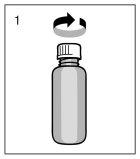
Mounting the doser on the bottle:
The doser must be removed from the plastic bag (fig.2) and placed on top of the bottle, carefully inserting the plastic tube into the bottle. The doser must be kept on the neck of the bottle and turned clockwise until it is firmly attached (fig.3). For the desired use, the doser should only be screwed on once when starting use and never unscrewed.
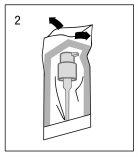
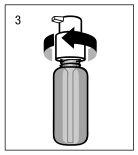
Using the doser for dispensing:
The doser head has two positions and can be easily turned – counterclockwise (open position) and clockwise (closed position). The doser head should not be pressed while in the closed position. The solution should be dispensed in the open position. To do this, the doser head must be turned one-eighth of a turn in the direction indicated by the arrow until resistance is felt (fig.4). The doser is then ready for use.

Preparing the doser:
When used for the first time, the doser does not dispense the correct amount of oral solution. Therefore, it must be prepared (primed) by pressing the doser head down completely five successive times (fig.5).
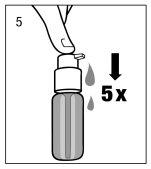
The dispensed solution should be discarded. The next time the doser head is pressed down completely (equivalent to one pulse), it already dispenses the correct dose (1 pulse is equivalent to 0.5 ml of oral solution and contains 5 mg of the active ingredient memantine hydrochloride; fig.6).
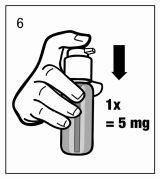
Correct use of the doser:
A glass with a little water or a spoon should be placed under the spout, and the doser head should be pressed down firmly but calmly and steadily (not too slowly) until the end (fig.7, fig.8).
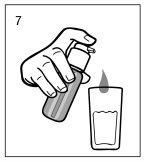
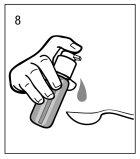
The doser head can then be released and is ready for the next pulse.
The doser should only be used with memantina cinfa 5 mg/pulse, oral solution in the provided bottle, not for other products or packaging. If the doser does not function correctly as described during use and according to the instructions, the patient should consult their doctor or pharmacist. The doser should be closed after use.
Dosage for patients with renal insufficiency
If you have kidney problems, your doctor will decide on the appropriate dose for your condition. In this case, your doctor should periodically monitor your kidney function.
Dosage for patients with hepatic insufficiency
Consult your doctor if you have liver problems.
Administration
Memantina cinfa should be administered orally once a day. To get the most out of your medication, you should take it every day and at the same time. The solution should be taken with a little water. The solution can be taken with or without food.
Duration of treatment
Continue taking memantina while it benefits you. Your doctor should evaluate your treatment periodically.
If you take more memantina cinfa than you should
In case of overdose or accidental ingestion, consult your doctor or pharmacist immediately or call the Toxicology Information Service, phone 91 562 04 20, indicating the medication and the amount ingested. It is recommended to bring the package leaflet and the medication packaging to the healthcare professional.
Generally, taking an excessive amount of memantina should not cause you any harm. You may experience an increase in the symptoms described in section 4 "Possible side effects".
If you forget to take memantina cinfa
If you realize you have forgotten to take your dose of memantina, wait and take the next dose at the usual time.
Do not take a double dose to make up for forgotten doses.
If you have any other questions about the use of this medication, ask your doctor or pharmacist.
4. Possible side effects
Like all medications, this medication can cause side effects, although not everyone will experience them.
Generally, side effects are classified as mild to moderate.
Frequent (may affect up to 1 in 10 patients):
- Headache, somnolence, constipation, elevated liver function tests, dizziness, balance disorder, shortness of breath, high blood pressure, and hypersensitivity to the medication.
Infrequent (may affect up to 1 in 100 patients):
- Fatigue, fungal infections, confusion, hallucinations, vomiting, gait disturbance, heart failure, and formation of blood clots in the venous system (thrombosis/venous thromboembolism).
Very rare (may affect up to 1 in 10,000 patients):
- Seizures.
Frequency not known (cannot be estimated from available data):
- Pancreatitis, hepatitis (inflammation of the liver), and psychotic reactions.
Alzheimer's disease has been associated with depression, suicidal ideation, and suicide. The occurrence of these events has been reported in patients treated with memantina.
Reporting side effects
If you experience any side effects, consult your doctor or pharmacist, even if they are possible side effects not listed in this package leaflet. You can also report them directly through the Spanish Medication Surveillance System for Human Use: https://www.notificaram.es. By reporting side effects, you can contribute to providing more information on the safety of this medication.
5. Storage of memantina cinfa
Keep this medication out of sight and reach of children.
Do not use this medication after the expiration date stated on the packaging and on the bottle label after EXP. The expiration date is the last day of the month indicated.
This medication does not require special storage conditions. Once opened, the contents of the bottle should be used within 12 weeks.
The bottle with the mounted doser should be stored and transported only in a vertical position.
Medications should not be disposed of through wastewater or household waste. Deposit the packaging and medications you no longer need at the SIGRE collection point in your pharmacy. If in doubt, ask your pharmacist how to dispose of the packaging and medications you no longer need. This will help protect the environment.
6. Contents of the pack and further information
Composition of memantina cinfa
The active substance is memantine hydrochloride.
Each pulse of the doser (one pulse) releases 0.5 ml of solution containing 5 mg of memantine hydrochloride, equivalent to 4.16 mg of memantine. Each ml of solution contains 10 mg of memantine hydrochloride.
The other ingredients are potassium sorbate (E-202), non-crystallizable liquid sorbitol (E-420), and purified water.
Appearance of the product and contents of the pack
Memantina cinfa oral solution is a clear, colorless to slightly yellowish solution.
Memantina cinfa oral solution is presented in 100 ml amber glass bottles. A doser is included.
Marketing authorization holder and manufacturer
Marketing authorization holder
Laboratorios Cinfa, S.A.
Carretera Olaz-Chipi, 10. Polígono Industrial Areta.
31620 Huarte (Navarra)-Spain
Manufacturer
Chanelle Medical Unlimited Company
Dublin Road
Loughrea
Co. Galway (Ireland)
Date of the last revision of this package leaflet: May 2020
Detailed information on this medication is available on the website of the Spanish Agency for Medicines and Health Products (AEMPS) http://www.aemps.gob.es/
You can access detailed and updated information on this medication by scanning the QR code included in the package leaflet and packaging with your smartphone. You can also access this information at the following internet address: https://cima.aemps.es/cima/dochtml/p/78316/P_78316.html
QR code to: https://cima.aemps.es/cima/dochtml/p/78316/P_78316.html
- Country of registration
- Active substance
- Prescription requiredYes
- Manufacturer
- This information is for reference only and does not constitute medical advice. Always consult a licensed doctor before taking any medication. Oladoctor is not responsible for medical decisions based on this content.
- Alternatives to MEMANTINE CINFA 5 MG/DOSE ORAL SOLUTIONDosage form: TABLET, 10 mgActive substance: memantineManufacturer: Merz Pharmaceuticals GmbhPrescription requiredDosage form: TABLET, 10 mgActive substance: memantineManufacturer: Merz Pharmaceuticals GmbhPrescription requiredDosage form: TABLET, 20 mgActive substance: memantineManufacturer: Merz Pharmaceuticals GmbhPrescription required
Alternatives to MEMANTINE CINFA 5 MG/DOSE ORAL SOLUTION in other countries
The best alternatives with the same active ingredient and therapeutic effect.
Alternative to MEMANTINE CINFA 5 MG/DOSE ORAL SOLUTION in Poland
Alternative to MEMANTINE CINFA 5 MG/DOSE ORAL SOLUTION in Ukraine
Online doctors for MEMANTINE CINFA 5 MG/DOSE ORAL SOLUTION
Discuss dosage, side effects, interactions, contraindications, and prescription renewal for MEMANTINE CINFA 5 MG/DOSE ORAL SOLUTION – subject to medical assessment and local rules.











